Kafia M. Shareef¹, Lazeza A. Omer² and Sirwan A. Garota³
¹College of Nursing, Hawler Medical University, Kurdistan (Iraq)
²Department of Biochemistry, College of Pharmacology, Hawler Medical University, Kurdistan (Iraq)
³Department of Surgery, College of medicine, Hawler Medical University, Kurdistan (Iraq)
Abstract
Gallstones represent a prevalent and costly health problem. Chemical composition of gallstone is essential for aetiopathogenesis of gallstone diseases. This study aimed to define patterns of gallstone composition in 162 samples surgically removed from as many patients 144 females and 18 males, age range 15 to 75 years, admitted for treatment in Rizgary Teaching Hospital, Kurdistan, Iraq, during 2007-2008. All stones were analyzed by Fourier transform Infrared (FTIR) Spectroscopy for cholesterol, bilirubin and calcium carbonate. Of the 162 samples of gallstones analyzed, 108 (66.7%) were identified as pure cholesterol stones, 52 (32.1%) were mixture of cholesterol + bilirubin and only 2 (1.2 %) were identified as calcium bilirubinate. Gender wise comparisons revealed that majority of gallstones were recovered from the female patients. We also concluded that, incidence of gallstone was higher in age group ³ 45 years.
Keywords
Gallstone; FTIR; chemical composition; mixed gallstone; cholesterol; bilirubin; calcium carbonate
Download this article as:| Copy the following to cite this article: Shareef K.M , Omer L.A , Garota S.A. Predicting the Chemical Composition of Gallstones by FTIR Spectroscopy. Biomed Pharmacol J 2008;1(1). |
| Copy the following to cite this URL: Shareef K.M , Omer L.A , Garota S.A. Predicting the Chemical Composition of Gallstones by FTIR Spectroscopy. Biomed Pharmacol J 2008;1(1). Available from: http://biomedpharmajournal.org/?p=188 |
Introduction
Gallstones represent a serious burden health care systems: 10-20% of Europeans and Americans carry gall bladder stones (1,2). The prevalence of gallstones disease is rising, possibly as a result of longer life expectancy and altered nutritional habits.
In particular, the increase of life style related risk factors was assumed to result primarily in an increase of cholesterol gallstones(3). The impact of life style and ethnicity is underscored by the profoundly different gallstone composition in recent studies from sub-Saharan Africa (4) and China (5,6). Many gallstones are silent, but symptoms and complications ensure in around 25-50% of cases.
The identification of the components of gallstones is essential as it provides information that could be useful for practitioners to find out the underlying cause of gallstones and to decide whether to treat gallstone patients therapeutically or surgically (7,8)
According to literature data, cholesterol, and bilirubin. Bile and fatty acids and their calcium salt and inorganic compounds (mainly calcium carbonate) are the general components of all gallstones(9,11), in addition to major , minor and trace elements namely S,Cl,K,Co,Ti,Ca,V,Cr,Mn,Fe,Ni,Cu,Zn,Br,Fe and Pb(12-16). An abnormal case of a premature neonate who developed calcium oxalate –phosphate gallstones detected at four months of age(17).The application of novel preventive of therapeutic non-surgical approaches will likely limited to certain classes of gallstones as defined by their composition and etiology . The pathogenesis of gallstones is not clearly understood (18). Analysis of the chemical composition of gallstones offers clues to the pathogenesis of gallstones. Chemical analysis of gallstones was done by FTIR spectroscopy , a technique requiring neither crystalinity nor volatilization to quatitate cholesterol ,bilirubinate and calcium carbonate(19).No study of the chemical analysis of gallstone from patients in Erbil has been carried out to date, the present study was conducted to describe the chemical composition of gallstones recovered from patients in our area.
Materials and Method
Gallstones from 162 patients of cholelithiasis were collected after cholecystectomy at local hospital (Rizgary Teaching Hospital) during 2007-2008 .In all , 162 gallstones were collected from 144 female and 18 males , age range 20-75 years . The stones were divided into 3 groups(20) depending upon their color pale yellow and whitish stones as cholesterol calculi, black and blackish brown as pigment calculi brownish yellow or greenish with laminated features as mixed calculi . The other relevant information’s about the patients such as age, sex, number of calculi and the date of operation were obtained from hospital records. All gallstones removed during surgery were placed on sterile gauze to air dry and then washed carefully with doubly distilled deionized water (to removed bile and debris) and dried over silica gel for at least seven days.
After noting the morphological features such as color and shape , single gall stone from each patient ( heaviest one in case of multiples ) was cut into quarters using a jeweler saw ( to obtain representative samples from center and periphery ) and one quarter was ground separately with pestle and mortar for 5 minutes .This process produced a fine homogeneous powder. Then stored in a sample tube, kept over silica gel in dark cabinate until analyzed for composition.
One to two milligrams of the resulting powder were mixed with300 milligrams of potassium bromide and pressed with eight to nine tons ( corresponding to 0.7-1 Gpa ) to generate KBr disk with 13 mm diameter(7) . These slices were measured using FTIR spectrometer on a FTS, IR 300 spectrometer thermo, Mattson, ( 095-3490) in the range of 400-4000 cm-1 resolution .
Control spectra from the manufactures library were used for comparison with pure cholesterol, bilirubin and calcium carbonate standard. Two samples for each stone composition were analyzed. The composition of the central, the periphery and the whole stone powder for cholesterol gallstones were determined.
Results
By the help of chemical composition of gallstones, proper management of the disease and prevention of its reoccurrence is possible. Typical FTIR spectra of three different standards, cholesterol, bilirubin and calcium carbonate are shown in figures 1to 3,then compared with the typical FTIR spectra of gallstone samples. Figures 4to 6 show the typical FTIR spectra of the selected gallstone samples, which were ≥90% matched with the spectra of the standards and identified.
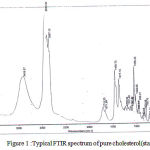 |
Figure 1: Typical FTIR spectrum of pure cholesterol (standard).
|
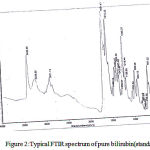 |
Figure 2: Typical FTIR spectrum of pure bilirubin (standard).
|
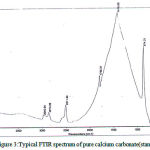 |
Figure 3: Typical FTIR spectrum of pure calcium carbonate (standard).
|
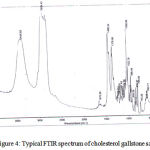 |
Figure 4: Typical FTIR spectrum of cholesterol gallstone samples
|
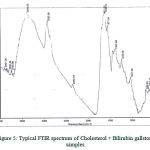 |
Figure 5: Typical FTIR spectrum of Cholesterol + Bilirubin gallstone samples.
|
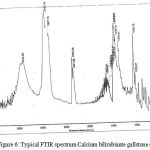 |
Figure 6: Typical FTIR spectrum Calcium bilirubiante gallstone samples.
|
Table 1 presents the type of gallstone identified, their occurrence and presentage.Out of 162 gallstones 108 (66-7%) were identified pure cholesterol, 52 (32.1%) were mixed stones and only 2 (1.2%) were identified as pigment stone .All the mixed component gallstones were of cholesterol + bilirubin type.
Table 1: Types, number and percentage of stones recovered from patients.
| Type of stones | No. of stone | Percentage |
| Pure cholesterol | 108 | 66.7 |
| Cholesterol + Bilirubin | 52 | 32.1 |
| Calcium bilirubiante | 2 | 1.2 |
| Pure calcium carbonate | – | – |
| Cholesterol + Calcium carbonate | – | – |
Table 2 presents IR bands of principle components observed in the studied gallstones. The diagnostic bands identified for cholesterol were the strong bands around 3438, 2935 ,1465 and 1056 cm-1 while the diagnostic band for bilirubin and calcium bilirubinat were 1633,1565,and 1275 ,1661,1249,1397, and 1435 cm-1.
Table 2: Types of gallstones identified and IR bands of principal components observed in analyzed gallstones.
| Gallstones | Principal IR observed bands | |
| Pure cholesterol | 1 | 2958.43, 2899, 2866.6 1466.24 |
| 1056.56 | ||
| Cholesterol + Bilirubin | 2 | The same bands corresponding to pure cholesterol and 1670.19 1636.2 |
| Calcium bilirubiante | 3 | 3399.85 1661.93 1397.96 |
| Pure calcium carbonate | 4 | – |
| Cholesterol + Calcium carbonate | 5 | – |
Comparison of composition of different parts of gallstones(central and the peripheral parts) with the whole stone powder, are shown in figures 7,8 and 4 respectively. The results revealed that cholesterol was present in high concentration in all parts of the studied cholesterol gallstones.Data in table 3 revealed that majoring (88.9%) of gallstones were recovered from the female patients. Informations in table 4 disclosed that majority of stones (51.2%) were recovered from the patients of age ≥ 45 years.
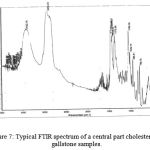 |
Figure 7: Typical FTIR spectrum of a central part cholesterol of gallstone samples.
|
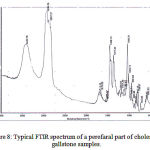 |
Figure 8: Typical FTIR spectrum of a perefaral part of cholesterol gallstone samples.
|
Table 3: Gender wise comparison of stones recovered from patients.
| Percentage | No. of stone | Gender |
| 88.9 | 144 | Female |
| 11.1 | 18 | Male |
Table 4: Age wise comparison of gallstones recovered from patients.
| Percentage | No. of patients | Age / Years |
| 19.1 | 31 | 25-29 |
| 29.6 | 48 | 30-44 |
| 51.2 | 83 | 45 and above |
Discussion
Pure cholesterol gallstone were characterized by the bands around 2958.43, 1466.24 and 1056.56 cm-1 cholesterol in mixed composition stones was characterized by the bands between 2800-3000 cm-1 due to asymmetric and symmetric stretching vibrations of CH2 and CH3 groups as far as pure cholesterol gallstones were concerned, some had a radial structure from the center to the periphery on cross section. Whereas most had pigment at the center and grossly visible cholesterol crystals at periphery. Comparison of composition of different parts of gallstones, central part, the periphery (Figs.7,8) and the whole stone (Fig.4) revealed that , concentration of cholesterol was markedly high in the periphery, center and in the whole stone powder.
Data in tables 1 and 2 revealed that most prevalent substance was cholesterol which was detected in 95% of the studied gallstone samples. Thus cholesterol gallstone represents the dominating type of gallstone. Our observation is in agreement with those observed in study from Northern German(18) and in contrast to that from sub-Saharan Africa(4)
The characteristics band features and key band locations (Table 2) for the components of gallstones in the present study were agreement with those reported in literatures (21,22). The cholesterol gallstone disease is indeed a multifactorial disease. The important epidemiological risk factors for cholesterol gallstone formation include diabetes mellitus(23), physiological stress(24), parity(25) and diet low in calcium(26) .Additional factors associated with cholesterol gallstone disease are sedentary life styl, obesity, aging, feminity, diet rich in saturated fats , simple sugars and other dietary factors like consumption of rapeseed oil , cotton seed oil , butter ,beans , tomatoes and tea . Although, it is generally a greed that gallstone composition mainly depends upon dietary habits of the patients, there is still littlie agreement about the risk of specific dietary components for specific type of gallstone (27). Gender wise comparison revealed that out of 162 gallstone patients , 144 were females and only 18 were males and thus the females to male ratio was 8:1, which was in accordance with literatures, Rains(28)advocated that concentration of bile salts in bile is reduced by oestregen and there by making it lithogenic. Horn (29) postulated that under the influence of female sex hormones, the muscle may relax, billiary passage dilates and duodenal content of pancreatic secretion regurgitates into gallbladder and promote conditions which favor the formation of gallstones. Cuevas et al (30) concluded that females had a greater risk of gallstone diseases, especially if they had used oral contraception and /or had four or more children.
Out of the total number of gallstones collected , the incidence of gallstones was higher in age group 45 years and above (Table 4) .Our observations are in conformity with with earlier study from Hayana(8) and also reports from Assam(2) and Aligarh. (3)
Conclusion
Analysis of gallstones based on FTIR revealed that cholesterol either singly or in combination with either bilirubin or calcium carbonate is the most predominant component of gallstones in Erbil, Kurdistan, Iraq. The concentration of cholesterol was markedly high, both in the periphery and center of the gallstones , Gender wise comparison revealed that majority of gallstones were recovered from the female patients. We also concluded that , incidence of gallstone was higher in age group ≥ 45 years . Our study suggests that cholesterol and bilirubin are the main risk factors of gallstone diseases .
References
- lammert F, sauerbruch T. Mechansim of diseases: the genetic epidemiology of gallbladder stones . Nat clin pract gastroenterol Hepatol 2005; 2:423-433.
- Volzke H. baumeister S, Alte D, Hoffmann w , Schwah C,Simon P ,John U , Lerch M. Independent risk factors for gallstone formation in region with high cholelithiasis prevalence . Digestion, 2005; 71:97-105.
- Paigen B,Carey M. Gallstones in : king RA. Editor, the genetic basic of common disease, London Oxford University press 2002: 298-355.
- Angwafa E, 3rd Takongmo S Griffith D. Determination of chemical composition of gallbladder stones: basic for treatment strategies in patients from Yaounde, carmeroon. World J Gastroenterol 2004; 10: 303-305.
- Hokg, Lin X, Yu, S, Chen Js, Wu C. Cholelithiasis incidence, bile lipid composition, and role of beta-glucuronidase. Dig Dis Sci 1995; 40:1963-1973.
- Tsai w , lai K, LinC, Chan H , Lo C , Hsup l, Chen w , Cheng J,LO G. Composition of common bile duct stones in Chinese patients during and after endoscopic sphinctertomy. World J Gastroenterol 2005; 11:4246-4249.
- Naseem A, Fateh D, Tayab U. Analysis of human gallstones by Fourier Transform Infrared ( FTIR) Pak J med Sci. 2007; 3:4 :546-550.
- Pundir G, Chandahary R, Rani K, Chandaran P, Kumari M, Garg P, Chemical analysis of biliary calculi in Hayana. Ind J Surg 2001; 63:370-73.
- Nikitina E, Kuzmicheva G, Orlova S, Efimova y. X-ray diffraction study of gallstone. 22nd European crystallographic meeting ECM22 , Budapest , 2004 Acta cryst . 2004 ; A60: s 299.
- Suzuki N, Nakamura Y, Sato T. Infra red absorption spectroscopy of pure pigment gallstones, Tohoku J Exp. Med. 1975; 116(3): 259-65.
- Kaufman H , Magnuson T , Pitt H, Frasca P Lillemoe K. The distribution of calcium salt precipitates in the core , periphery and shell of cholesterol , black pigment and brown pigment gallstones.
- Moosavi K, Vatankhah S, salimi J. Relative messurement of heavy elements in the bile , gallbladder and gallstones ; Iran J radiat Res. 2006;3(4):195-198.
- Rautray , Tapash r , Vijayan , Venkatathri B , Panigrahi , Simanchalo A. Analysis of Indian gallstones by particle –induced x-ray emission and thermogravimetry – derivative thermogravimetry, European J of Gastroenterology & Hepatology 2006 18(9) :199-1003.
- Sahuquillo A, Rubio R, Ribo J ,Ros E, Vela M. Application of focused – microwave wet digestion to the determination of trace metals in human gallstones by 1CP/AES 2005.
- Pundir C, Rani K , Gary P, Chaudhary R , Chandran P, Kumari M. Correlation between chemical composition of biliary calculi and sera of stone formers . Indian J Med. Sci. 2002; 56:373-5.
- Robert C , Dale T, Connie N, Andrew D , Steven M. Quantitative analysis of major , minor and trace elements in gallbladder bile of patients with and without gallstones , Hepatology 2005; 5(1): 129-132.
- Paul W, Frank M, Alan F, Brain N, David K. Calcium oxalate –phosphate gallstones, a unique chemical type of gallstone (case report). CLIN .CHEM. 1982; 28(8): 1804-185.
- Clemens s, Jurgen H, Jurgen T, Stefan A, Sandra F , Henry V , Stephan B, Markus S , Birgit T , Brend K, Ulrich R , Fred F, Micheal K, Stefan S, Jochen H. Predictors of gallstones composition in 1025 symptomatic gallstones from Northern Germany . BMC Gastroenterology 2006;6(36):1-26.
- Trotman B, Ostrow J, Soloway R, Pigments vs Chlesterol cholelithiasis : comparison of stone and bile composition. Am J Dig Dis. 1974; 19:585-590.
- Chandran P, Kuchhal N, Gary P, Pundir C. An Extended chemical analysis of gallstones, Indian Journal of clinical Biochemistry 2007;22 (2): 145-150.
- Kleiner O, Ramesh J, Huleihel M. A comparative study of gallstones from children and adult using FTIR Spectroscopy and fluorescence microscopy , BMX Gastroenterology 2002;2(3): 1-14.
- Zhou x. Shen G, Wu J. A spectroscopic study of pigment gallstones in China, Biospectro 1997; 3:371-80.
- Liu C, Tung H, Lee W, Chou P. A community-based epidemiologic study on on gallstone diseases among type 2 diabetics in Kinmen,Taiwan,Dig Dis 2004;22(1):87-91.
- Geetha A. Evidence for oxidative stress in the gall bladder mucosa of gallstone patients. J Biochem Mol Biol Biophys 2002; 6 :427-43.
- Lindseth G, Bird-Baker. Risk factors for cholelithiasis in pregnancy.Res Nurs Health 2004;6:382-92.
- Cuevas A, Miquel J, Reyes M, Zanlungo S, Nervi F. Review: Diet as a risk factor for cholesterol gallstone diseases J Am College of Nutr 2004;23(3):187-96.
- Johnson E. Pathogenesis and treatment of gallstones, N Eng J Med. 1993;328:412-21.
- Rains A. gallstones: Heinmann Monography 1ST ed. 1984.
- Horn G. Observations on the aetiology of cholelithiasis,Bri Med J. 1965;2:731.
- Moore E . The Role of calcium in the pathogenesis of gallstones. Hepatology. 1984; 4: 228-43.







